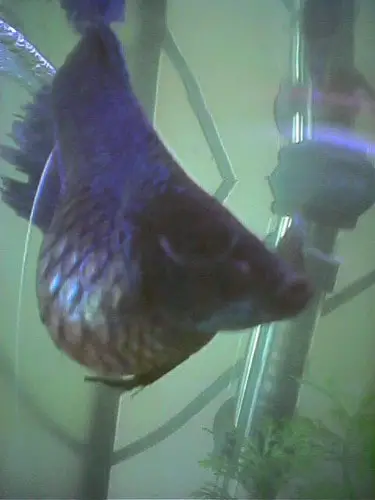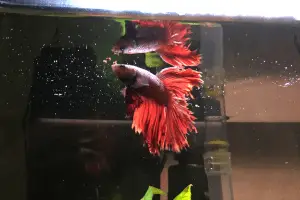Does it look as if your Betta has suddenly forgotten how to swim properly? A Betta stuck at the bottom or unable to leave the surface may have a Swim Bladder Disorder.
These disorders are very common in the hobby and sometimes difficult to treat because they can come from a variety of sources. So I think it’s time we discussed what Swim Bladder Disorder is and how you can help your Betta swim normally again!
What is Betta Swim Bladder Disorder?
Swim Bladder Disorder (SBD) is a general term for buoyancy problems that many aquarium fish contract. Swim bladders aren’t an organ we humans have so let’s take a moment to understand what one is!
What is the Swim Bladder?
Most bony fish (unlike sharks and rays) have a Swim Bladder. This gas-filled internal organ helps fish regulate their buoyancy so they can swim through the water column with less effort.
The swim bladder also acts as a stabilizer since it runs along the length of the spine. The number of swim bladders varies but most species have 1-2.
Believe it or not, the swim bladder is what eventually evolved into the lungs we land animals use! Like lungs, swim bladders can expand and contract slightly as necessary. But only a few fish (including lungfish) use them for breathing.
Symptoms of Swim Bladder Disorder
There are many types of Swim Bladder Disorder and the symptoms vary quite a bit. Here are the most common signs and symptoms to help diagnose SBD in your Betta:
- Helplessly floating at the surface: this is the most common sign of SBD. Struggling at the surface shows that your Betta’s natural buoyancy is somehow not what it should be.
- Listlessness and clamped fins: Bettas with SBD tend to hang either near the bottom or at the surface, rarely moving much. Clamped fins are typically a sign of sleeping or stress in Bettas.
- Loss of appetite: your Betta may show reduced interest in food if affected by SBD. Low temperatures may also be a factor here (see below)
- Swollen appearance: SBD can also cause your Betta’s body to visibly bloat. Scales may stand out like a pinecone, especially if Dropsy is the cause. In extreme cases, the eyes may also protrude.
Causes of Betta Swim Bladder Disorder
Swim Bladder Disorder is actually hard to diagnose properly because any one of a Betta’s internal organs can get infected and cause bloating.

Air can also get trapped in the stomach and intestines, causing the fish to float. This looks like SBD but eventually ends once the fish passes gas.
True SBD is typically the result of an internal bacterial or parasitic infection. Dropsy is a disease most often misdiagnosed as SBD and is caused by fluid buildup in the body cavity in response to bacteria.
The most common condition that is identified as Swim Bladder Disorder is intestinal bloating due to slow digestion or constipation. If you keep your Betta in especially low temperatures or don’t pre-soak your prepared foods, digestion slows along with their metabolism. This can also be caused by simply feeding the betta too much food.
Once this happens food can actually rot inside before getting digested. This rot causes internal gases to build up, leading to your Betta floating as if its swim bladder is affected!
Some aquarists watch their Betta gulping air from the surface and worry they can contract SBD this way. Bettas are actually partial air breathers!
They use a complex labyrinth organ to get additional oxygen from the atmosphere, which is why they can survive in bowls and jars with no plants or water movement.
Prevention of the Disease
Prevention is always the best medicine when it comes to any fish disease. The best way to ensure Swim Bladder Disorder never happens is to keep your Betta’s environment warm and the water clean and well filtered.
Room temperatures below 72℉ significantly slow your Betta’s metabolism, which reduces both digestion and immune responses. Combined with the poor water quality they sometimes find themselves in, opportunistic bacterial infections are only a matter of time.
Consistent exposure to high levels of ammonia, nitrite, and nitrate is also stressful and can lead to infections. So make sure your water changes are always timely.
In the case of constipation ensure you are not overfeeding your betta and consider pre-soaking its food. An occasional 2 day fast where you don’t feed your betta anything can also be beneficial. I would recommend doing this once a month or so.
Cures and Treatment
Swim Bladder Disease is tricky to treat once it’s begun. However, you do have a few options to help reduce your betta’s swelling and get him back to good health.
Provide Tropical Temperatures
Lack of warmth is a major cause of SBD. Bettas can survive at lower temperatures but they really are Southeast Asian tropical fish. They prefer being kept at 76-82℉; any colder is uncomfortable and puts them at risk for several diseases.
Warmth speeds up the digestive process so food doesn’t sit too long inside the intestines. And warmth ensures their immune system can respond properly to opportunistic germs before they can cause infection.
Ease Up on Feeding

If you think your Swim Bladder Disorder may be the result of internal rotting food or constipation, don’t feed your Betta fish food for 2-3 days. Instead, you can feed a small piece of a pea (1/4) once a day until its digestive system clears. You’ll also want to provide tropical temperatures as mentioned earlier.
Feeding your betta peas works well to clear simple constipation but won’t do much for internal bacterial infections. In this case, it doesn’t need fiber. It simply needs time and warmth to naturally clear its digestion and allow its immune system to do its job.
Medications
If all else fails or you have a serious case with severe bloating and pinecone scales, medication may be the only way to save your Betta. You should also provide tropical temperatures and either withhold or provide less food for a few days to see if his condition improves.
Melafix
For bacterial infections, I highly recommend the fish medication Melafix by API. Melafix uses tea tree oil as its main ingredient, which has potent antibacterial properties.
It’s fast-acting yet won’t kill beneficial nitrifying bacteria that live in the substrate or filter. Combined with warmth Melafix can reduce bloating in days.
Aquarium Salt
Aquarium salt is not very effective against SBD itself. Salt is typically used for internal and external parasites while SBD is usually a bacterial disorder.
Still, a light dose following the instructions on the box is a good general stress tonic.
Aquarium salt stimulates slime coat production and helps regulate proper gill function, which gives your Betta more of a fighting chance if he’s in critical condition.
Summary
While it can be confusing, Swim Bladder Disorder does not need to be a death sentence. Prevention is also the cure in this case. By keeping your Betta warm and clean SBD should never be an issue!
